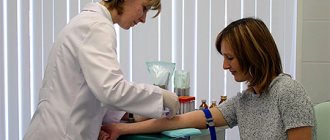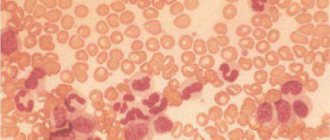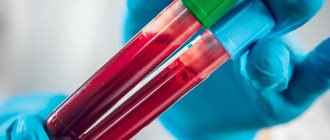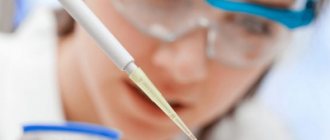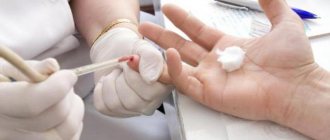Thyrotoxicosis
Hepatitis
Diabetes
4177 06 August
IMPORTANT!
The information in this section cannot be used for self-diagnosis and self-treatment.
In case of pain or other exacerbation of the disease, diagnostic tests should be prescribed only by the attending physician. To make a diagnosis and properly prescribe treatment, you should contact your doctor. We remind you that independent interpretation of the results is unacceptable; the information below is for reference only.
Glucose (in blood) (Glucose): indications for prescription, rules for preparing for the test, interpretation of results and normal indicators.
Indications for the purpose of the study
A blood glucose test is a routine biochemical test that is used to diagnose and control diabetes mellitus (types I and II, gestational diabetes (pregnant diabetes)) and other diseases associated with impaired carbohydrate metabolism.
Diabetes is a disease that belongs to the group of metabolic disorders of carbohydrate metabolism, which is based on a lack or low biological activity of the hormone insulin, which leads to an increase in blood glucose levels (hyperglycemia). Chronically elevated blood glucose levels can lead to serious health consequences.
Glucose levels are primarily affected by the hormone insulin, which is synthesized in the pancreas. In addition to insulin, the following are involved in maintaining carbohydrate balance: glucagon, a hormone also synthesized by the pancreas and acting as an insulin antagonist, hormones of the pituitary gland (somatotropin, thyrotropin), thyroid gland (T3 and T4) and adrenal glands (adrenaline and cortisol).
A doctor may order a blood glucose test if a patient has symptoms of hyper- or hypoglycemia.
Symptoms of high blood glucose (hyperglycemia) include:
- frequent urination;
- thirsty;
- blurred vision;
- fatigue;
- slow healing of wounds.
Symptoms of low blood glucose (hypoglycemia) include:
- anxiety;
- cardiopalmus;
- sweating;
- shiver;
- hunger;
- confusion.
A blood glucose test is necessary if you have risk factors for diabetes:
- excess body weight;
- sedentary lifestyle (hypodynamia);
- presence of diabetes mellitus in close relatives;
- high blood pressure;
- cardiac ischemia;
- chronic liver diseases;
- pregnancy.
Gestational diabetes
is a special form of diabetes that occurs only during pregnancy and is associated with hormonal changes.
Therefore, women who have been diagnosed with this pathology should monitor their blood glucose levels throughout pregnancy.
Types of analyzes
To make a diagnosis suggesting the presence of diabetes mellitus or other endocrine pathology, a number of blood composition studies are carried out, including:
- glucose tolerance test (its tolerance in high doses), simply called sugar load;
- measuring the percentage of glycated hemoglobin in it;
- fructosamine test;
- rapid test (express method), assessing the level of a given carbohydrate in the blood.
Definition of tolerance
The method called the glucose tolerance test is also known as:
- glucose tolerance test;
- oral (or oral) tolerance test;
- oral glucose tolerance test.
The absolute indications for this are suspected disorders of carbohydrate metabolism (including latent and initial forms of diabetes mellitus - prediabetes), as well as monitoring its condition in already identified and treated patients.
Relative indications are the frequency of testing upon reaching a certain age: for those under 45 years old it is once every 3 years, for those who have reached it – once a year.
The principle of the method is an artificially arranged check of the level of carbohydrate disorders at the peak of insulin production.
The procedure involves determining the concentration of a given carbohydrate in the blood repeatedly:
- on an empty stomach;
- after every 30 minutes (30-60-90-120) after the sugar load (according to the classical scheme);
- after 1 and 2 hours - according to a simplified scheme.
Technically, a sugar load looks like drinking a solution of a certain concentration, designed for the age of the subject. For adults this is glucose in the amount of 75 g/250-300 ml of water, for children 1.75 g/kg body weight.
There is a nuance: in the case of adults with a body weight over 75 kg, 1 gram of this substance is added for each kilogram (its total mass cannot exceed the limit of 100 g).
The solution is drunk over 3-5 minutes. If it is impossible to do this (the presence of intolerance or deterioration in health), the solution is injected into a vein according to the calculation (0.3 g/kg body weight).
To ensure the reliability of the results, at least two studies are carried out; if they are performed multiple times, the interval between samples should be at least 30 days.
The value for diagnosis is that the described test is a more sensitive method than a blood test taken on an empty stomach; in some cases, the test can replace a blood sugar test after a meal.
Interpretation (interpretation) of the results is a comparison of the concentrations of the test substance in the fasting state and 2 hours after drinking the solution.
If for the norm the first indicator is less than 5.5, and the second is less than 7.8, then for tolerance disorders the same data are respectively:
A figure of more than 6.1 (on an empty stomach) and more than 11.1 mmol/l (2 hours after exercise) suggests the presence of diabetes.
What may affect the results
Eating food, alcohol, certain medications, fatigue, or stress can affect your blood glucose levels.
Medicines that may cause increased blood glucose levels.
- Corticosteroid hormones (another name is glucocorticoids). They are intended to treat diseases caused by inflammation: rheumatoid arthritis, lupus, allergies. Systemic (tablet form, intravenous or intramuscular) steroids include hydrocortisone and prednisolone. However, topical steroids in creams and ointments or inhaled steroids (used to treat asthma) do not significantly affect glucose levels.
- Medications for anxiety, attention deficit disorder, depression and other mental health problems.
- Oral contraceptives (birth control pills).
- Some medications to normalize high blood pressure.
- Statins, used to lower cholesterol levels.
- Adrenaline (can be used for severe allergic reactions).
- High doses of non-inhaled asthma medications (given intravenously for severe attacks).
- Isotretinoin (used to treat acne and other dermatological conditions).
- Tacrolimus is an immunosuppressant (prescribed after organ transplantation).
- Some antiviral medications prescribed to patients with HIV and hepatitis C.
- Pseudoephedrine (a decongestant found in some cold and flu medications).
- Cough syrups (many contain sugar).
- Niacin (vitamin B3).
In addition to medications for the treatment of diabetes, the following medications and dietary supplements can reduce glucose levels:
- Aspirin.
- Aloe.
- Magnesium salicylate.
- Quinine.
To get the most reliable result, it is recommended to refrain from taking these medications until the test is taken, having agreed upon the timing of drug withdrawal with your doctor.
Female sex hormones also affect glucose levels, so a few days before your period, your glucose levels may be higher than on other days.
You can take a blood glucose test at the nearest INVITRO medical office.
A list of offices where biomaterial is accepted for laboratory research is presented in the “Addresses” section. Interpretation of study results contains information for the attending physician and is not a diagnosis. The information in this section should not be used for self-diagnosis or self-treatment. The doctor makes an accurate diagnosis using both the results of this examination and the necessary information from other sources: medical history, results of other examinations, etc.
Algorithm for collecting blood from a vein
When performing this manipulation, the nurse must follow the following procedure:
- Prepare a container for collecting biomaterial.
- The individual takes a horizontal position if he is dizzy, or sits on a chair.
- The patient extends his hand, palm up. The healthcare worker places a cushion under the elbow.
- A rubber tourniquet is applied to the forearm and the pulse is felt in the vein.
- The place where the needle will be inserted is treated with an alcohol solution. During this period, the individual is asked to use his hand to fill the vein with blood.
- A puncture is made with a needle at an acute angle. Its cut should be directed downwards.
- The nurse slowly pulls the plunger of the syringe up until blood appears inside it. On average, take no more than five milliliters.
- A sample of biomaterial is poured into a prepared test tube. The needle is removed and placed in a special container, and the syringe is placed in a container with disinfectants.
- A cotton pad moistened with an alcohol solution is applied to the puncture site. To avoid the formation of hematomas, the patient is recommended to bend his arm at the elbow for at least five minutes.
- The tube is labeled and sent to the laboratory.
The algorithm for collecting biomaterial from children is practically no different from that described above. However, in this case, factors such as:
- During the manipulation, parents should distract the baby due to his fear of injections.
- Blood sampling can be taken from the forearm, the back of the hand, the head, or the vein of the elbow.
- Twenty minutes before the test, the child should be in a calm state.
Vacuum blood sampling has some advantages over the conventional method:
- contact of a medical worker with biomaterial is excluded;
- the test tubes are made of unbreakable material;
- the number of nurse actions decreases.
The process of collecting biomaterial using vacuum tubes is basically the same as the conventional method. The difference is observed only in the process of puncture of the vein.
Blood glucose test
Glucose is an organic compound that is the main source of energy for the body's cells and the only one for the brain and nervous system. For the normal functioning of all organs and systems of the body, a relatively constant level of glucose must be maintained. During digestion, carbohydrate sources are broken down into glucose and other nutrients; they are absorbed by the small intestine and distributed throughout the body. The use of glucose for energy depends on insulin, which facilitates the transport of glucose into the body's cells and stimulates the liver to store excess energy as glycogen for storage.
Typically, blood glucose levels rise slightly after eating, and the pancreas responds by releasing insulin into the blood in an amount appropriate to the size and content of the meal. As glucose enters cells and is metabolized, blood levels drop and the pancreas responds by slowing and then stopping the release of insulin.
What does glucose do for the body?
Blood biochemistry makes it possible to identify the presence of pathologies in the human body that are associated with the functioning of internal organs.
This analysis is mainly used to diagnose the condition:
- liver;
- kidney;
- endocrine system;
- hearts.
Disruption of metabolic processes and hormonal levels usually has a dramatic effect on the indicators in a biochemical blood test. The first alarming symptom can be considered a change in sugar levels. This is how the body reacts to the development of serious diseases.
An element such as sugar is present in human blood in certain quantities.
When the level of this substance increases or decreases, the body malfunctions. Glucose provides energy metabolism, that is, it supplies cells with energy to maintain vital functions. Therefore, with a low content of the substance, energy metabolism is disrupted at the very beginning, which, in turn, affects the biochemical processes occurring in the body. Accordingly, an increase in sugar leads to the opposite process. Any imbalance is harmful to human health.
Glucose enters the body along with food. After eating, the level of the substance increases slightly in the body, and then is evenly distributed and returns to normal. But in people suffering from diabetes, this level increases significantly, which manifests itself in a sharp deterioration in health.
What does imbalance lead to?
- Reduced protective functions in the body.
- Impaired growth of bone tissue.
- Increased blood cholesterol.
- Disruption of the metabolic process.
All this can lead to a number of serious diseases that will cause serious damage to the human body.
To monitor your blood sugar levels, you should have regular blood tests. This is especially true for those patients who are at risk.
Decoding the result
Increased glucose levels (hyperglycemia)
Observed in the following diseases and conditions:
- Diabetes.
- Gestational diabetes (diabetes during pregnancy).
- Physiological hyperglycemia, causes: moderate physical activity, strong emotions, stress, smoking, adrenaline release after injection.
- Active infectious process.
- Trauma, recent surgery.
- Endocrine system diseases:
- a) pheochromocytoma - a tumor of the adrenal glands that produces adrenaline and is characterized primarily by a persistent increase in blood pressure; b) thyrotoxicosis – a pathological condition in which the thyroid gland begins to produce too many hormones (thyroxine and/or triiodothyronine); c) acromegaly is a disease associated with a violation of the synthetic activity of the pituitary gland (a gland located in the brain). It is characterized by excess production of growth hormone, leading to changes in facial features, enlargement of the hands and feet. d) gigantism - a pathology, also associated with the pituitary gland, is hereditary in nature, the first manifestations occur in early adolescence; e) Itsenko-Cushing syndrome is a condition in which the adrenal glands produce excessive amounts of cortisol. Characterized by a violation of carbohydrate metabolism; f) somatostatinoma - a tumor of hormonally active cells of the pancreas or cells located in the wall of the duodenum, secreting somatostatin; g) polycystic ovary syndrome - a symptom complex accompanied by the formation of cysts in the ovaries, menstrual irregularities, excess body weight, and infertility.
- Diseases of the pancreas (acute and chronic pancreatitis, pancreatitis with mumps, cystic fibrosis, hemochromatosis, pancreatic neoplasms).
- Chronic liver and kidney diseases.
- Cerebral hemorrhage, myocardial infarction.
- Taking thiazide diuretics, beta blockers, caffeine, oral contraceptives, glucocorticoids (a full list is presented in the section “What may affect the results”).
Low glucose levels (hypoglycemia)
- Patients with diabetes may experience low glucose levels in the following situations:
- a) insulin overdose; b) overdose of drugs that lower blood glucose levels; c) increased physical activity; d) skipping meals; d) drinking alcohol.
- Severe liver diseases (cirrhosis, hepatitis, carcinoma, hemochromatosis).
- Tumor diseases: pancreatic cancer, adrenal cancer, stomach cancer, fibrosarcoma.
- Reactive hypoglycemia is a condition in which blood glucose levels decrease 1-3 hours after eating.
- Dietary disorders (prolonged fasting, malabsorption syndrome - impaired absorption of nutrients due to intestinal diseases).
- Taking large doses of alcohol.
- Intense physical activity.
- Feverish conditions.
- Taking a number of medications:
- a) beta blockers (atenolol, propranolol, etc.) – used in the treatment of coronary heart disease, hypertension; b) flecainide and quinidine (drugs for arrhythmia); c) indomethacin (painkiller); d) insulin and other hypoglycemic drugs; e) some antibiotics, antifungal drugs; e) aspirin; g) a number of antiepileptic, anti-anxiety drugs (pregabalin); h) monoclonal antibodies for the treatment of tumor or autoimmune diseases.
